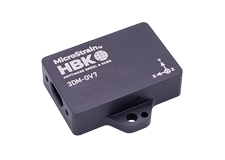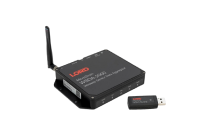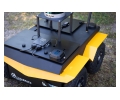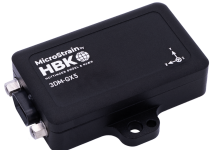MicroStrain 3DM-GQ7-GNSS/INS Tactical Grade Dual Antenna, Multi-band, RTK, Industrial Package
Firmware release 1.1.03 is now available! DOWNLOAD NOW for a vast array of new features and performance improvements or view the firmware changelog HERE.
Specs
Sensor
- Up to 1 cm + 1 ppm positional accuracy with RTK
- Multi-frequency GNSS receivers provide 1.2m single point L1/L2 position accuracy
- Multi-constellation receivers with 184 tracking channels each allow for rapid signal acquisition and robust signal tracking in challenging GNSS environments
- Dual GNSS antenna heading with 0.2° heading accuracy that is immune to magnetic disturbances
- Tactical grade IMU with <2°/hr bias instability provides exceptional position accuracy during GNSS outages
- 0.05° pitch/roll accuracy
Operation
- Accepts standard RTCM real-time kinematic (RTK) corrections
- Adjustable sampling rates up to 1KHz
- 34 state auto-adaptive EKF
- Independently configurable IMU, GNSS, EKF outputs
- Forward compatible MIP Protocol optimizes bandwidth
- SensorConnect software for configuration, control, display, and logging
- MSCL open source API for easy integration
Package
- Anodized Aluminum
- Precision alignment features
- Highly compact and low profile
- 76 mm x 68.6 mm x 13.3 mm
- 78 grams
- USB and RS-232 interfaces
- –40 to +85°C operating temperature range
Use Cases
Low-noise, low-drift MEMS gyros and accelerometers result in accurate and robust PVA (Position, Velocity, Attitude) outputs over harsh terrain
Auto-adaptive Kalman Filter algorithms provide exceptional dynamic performance
Exceptional IMU performance and robust anomaly rejection by the EKF aids navigation under GNSS outage or denied environments
Fully calibrated and temperature compensated IMUs provide stable performance in demanding environments
Low-noise, low-drift MEMS gyros and accelerometers result in accurate and robust PVA (Position, Velocity, Attitude) outputs during sharp turns, high winds, etc.
Exceptional IMU performance and robust anomaly rejection by the EKF aids navigation under GNSS outage or denied environments
Fully calibrated and temperature compensated guarantees stable performance in outdoor operating temperature ranges even with high levels of fluctuation
Low-noise, linear, and stable MEMS gyros and accelerometers enable superior heading accuracy during turns & bumps
Auto-adaptive Kalman Filter algorithms provide exceptional dynamic performance
Auto self-calibration and automatic anomaly rejection make units with magnetometer a reliable and accurate heading reference
Fully calibrated and temperature compensated IMUs provide stable performance in demanding environments
Documentation
General Documentation
Downloads
Software/Firmware
More
- 3DM-GQ7 Dimensions
- 3DM-GQ7 3D Model (STP File)
- ANN-MB GNSS Antennas Data Sheet
- 6212-3018 Dual GNSS Antenna Kit
- 6212-3019 GNSS Antenna
- 6212-3020 Adapter Cable
- 6212-3021 Connectivity Kit, RS232/GNSS Cable & Antennas
- 6212-3022 Connectivity Kit, USB/GNSS Cable & Antennas
- Micro D-to-USB Communication and Power Cable
- Micro D-to-RS232 Communication and Power Cable
- 9011-0058 PSA15R Wall Plug Adapter
- Craft Cable with Micro DB9 and Flying Leads
- 6285-0100 RTK Modem Connectivity Kit
Video
Software
SensorConnect
Free
SensorConnect is the next generation in desktop sensing software.
From configuration of nodes and starting networks, to collecting and analyzing data in real-time, SensorConnect provides a modern, powerful experience with our Wireless, Inertial, and Displacement products.
Using our intelligent data collection and graphing algorithms, you are able to visualize massive amounts of data instantly, and then zoom in on points of interest just as fast.
Built in MathEngine functionality allows for both real-time and post-processed math, such as generating FFTs, averages, RMS, etc.

{MSCL}
Free and open source API
The MicroStrain Communication Library (MSCL) makes it simple to write code that interacts with our Wireless, Inertial, and Displacement sensors.
MSCL is completely open source and hosted on GitHub under the MIT license.
Full documentation, example code, and a quick start guide are provided to help you get started.
Available for C++, Python, and .NET.

ROS
Robot Operating System (ROS) is an open-source, meta-operating system for your robot. It provides the services you would expect from an operating system, including hardware abstraction, low-level device control, implementation of commonly-used functionality, message-passing between processes, and package management. ROS can be used in building and simulating robotics applications, as well as unmanned ground vehicles and simultaneous localization and mapping (SLAM). To facilitate better integration within the ROS ecosystem Microstrain has develop an open source License free (MIT License) series of drivers specifically designed and tested for ROS.





















